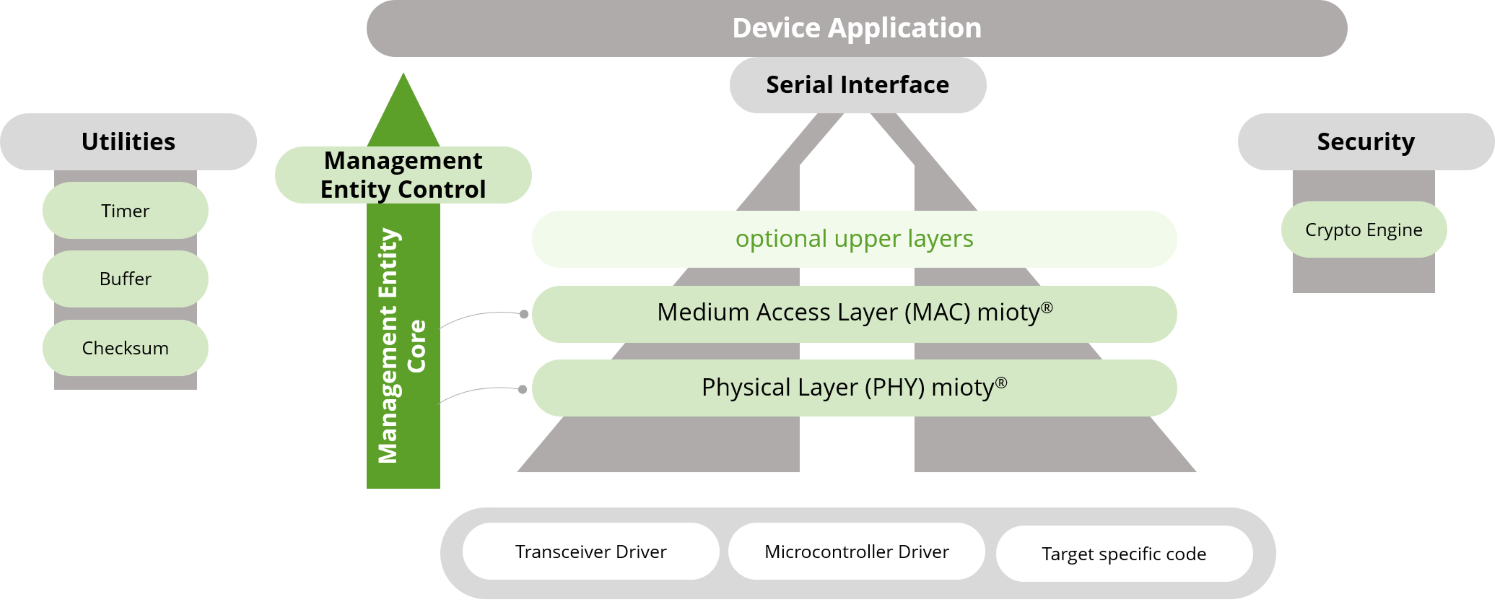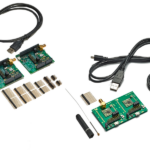Mioty (pronounced “My IoT”) is the latest contender in the increasing-crowded field of low power wide area network (LPWAN) offerings. According to the mioty website: “With its best-in-class reliability and scalability, mioty is designed for massive industrial and commercial IoT deployments.” Quite a goal. But with founders including Texas Instruments, Fraunhofer Institute for Integrated Circuits IIS, Diehl Metering, Diehl Connectivity Solutions, ifm, Ragsol, Stackforce, and Wika might just be achievable. Following this exploration into “what is mioty?” will be a FAQ comparing mioty with other popular LPWAN protocols. The concluding FAQ will look into the applications space and identify the initial applications that mioty is gunning for.
Mioty is a standardized software-based massive IoT connectivity solution operating in the license-free spectrum. A single mioty gateway can handle up to 100,000 sensor nodes and about 1.5 million messages per day with interference immunity and transmits data with ultra-low power consumption. At the time of this writing, the Mioty alliance membership includes 11 Full Members and 20 Associated Members.
Telegram Splitting Multiple Access (TSMA) is the main invention in the mioty technology. The European Telecommunications Standards Institute (ETSI) standard for telegram splitting (ETSI TS 103 357), uses an algorithm to parse the data packets to be transmitted into small sub-packets at the transmission source.
Mioty is based on the protocol family telegram splitting ultra narrowband (TS-UNB) of the ETSI TS 103 357 standard. These TSMA systems have a data rate of 512 bit/s. The UNB telegram is divided at the physical layer into multiple sub-packets, each equal in size. Each of which is randomly sent on a different carrier frequency and at a different time. The sub-packets are much smaller than the original telegram and only require an on-air time of 16 ms. The total air-time of all the sub-packets for a 10-byte telegram is about 390 ms.
The risk of suffering data loss resulting from interference is substantially reduced due to a combination of the virtually random distribution of sub-packet transmissions through time and varying frequencies. And, as a result of the use of sophisticated forward error correction (FEC) techniques, the receiver needs only about 50% of the packets to reconstruct the original telegram completely. The result is a much lower impact of corrupted or lost packets (and therefore, the whole telegram), due to collisions and greatly increased immunity to interfering than traditional LPWAN technologies.

Packet error rates (PER) over 10% are not unusual with traditional LPWAN solutions. With mioty PER are typically under 1%. Mioty uses 100kHz to 1.5MHz in the worldwide license-free spectrum.

ETSI TSMA overview
The ETSI TS 103 357 UNB family uses a star topology. No network synchronization is needed. The end-point starts communications at any time data is available. A crystal reference is used to ensure randomness. The asynchronous mode of system operation enhances frequency offset and random channel access in time. The protocol supports both Class A (bidirectional) and Class Z (uplink only) endpoints.
The technology is specially designed with battery- or energy harvesting-powered endpoints in mind. Channel coding with coherent MSK or GMSK demodulation is used to ensure a -139dBm sensitivity in the receiver with minimal narrowing of the signal bandwidth. Hence, the transmission time for a 10-byte telegram is under 400 ms. Power consumption per telegram is about 10 µWh in the end-point, which can also be operated in a low-duty cycle band (dc = 0.1 %). Network capacity of over one million telegrams per base station (within a 200 kHz spectrum) per day is supported as a result of the short transmission time of the UNB telegrams as well as the extremely high interference resilience of the system.
The ETSI TS-UNB family of protocols can handle variable application data with up to 245 bytes in the uplink and 250 bytes in the downlink. It is optimized for a data length of 10 bytes. AES128 encryption is used. A 32-bit cipher-based message authentication code (CMAC) is added to the MAC protocol data unit for authentication and integrity checking, and a 24-bit packet counter is used for replay protection. Finally, user-specified MAC functions can be implemented with an optional variable MAC mode.
Mioty implementation of ETSI TSMA
Mioty is a specific, patented implementation of ETSI TS-UNB telegram splitting. It is designed to minimize PERs, even in the crowded spectrum, and maximize the throughput of short messages. It is specifically designed for devices such as sensors that do not require high bandwidth or constant communications. The protocol, combined with battery recovery periods, can enable the use of smaller batteries. Battery life of 20 years or more can be achieved given mioty’s power consumption of 17.8 μWh (end-point, 868 MHz) per message. Additional features of mioty include:

Mobile connectivity: Moity can collect data from sensors moving up to 120 kph, enabling fleet management applications and various connector worker scenarios.
Private networks: Mioty networks are private and do not rely upon paid subscription services or monthly license fees. Private gateways are used for connectivity in the mioty star network architecture.
Scalability: Mioty operates without interference, and a single network can have hundreds of thousands of devices, potentially over one million devices, transmitting up to 1.5 million telegrams per day. Networks can start small and grow in size over time. The robustness of mioty supports nodes in hard-to-reach areas with poor propagation properties and physical obstacles.
Long-range on license-free frequencies: Mioty can support transmissions of a 20km line of sight, and with the use of strategically placed gateways, large environments such as industrial complexes and factories, mining, oil fields, and large agricultural operations can be covered.
High QoS: Mioty is structured to deliver near the carrier-grade quality of service (QoS), reliability, and robustness in challenging environments with high levels of interference in congested license-free segments of the spectrum. It is especially suited for industrial environments with metal or rebar obstructions and can support deep indoor connectivity.

Mioty licensing
Mioty operates in the worldwide license-free Sub-GHz spectrum, but it is not an open-source platform. Sisvel International S.A. operates the Mioty Licensing Platform, a new joint patent licensing effort for the mioty technology. The platform launched with patents owned or controlled by, Fraunhofer Institute for Integrated Circuits IIS and Diehl Metering GmbH.
Sisvel is organizing this licensing platform to make mioty technology accessible on fair, reasonable, and non-discriminatory terms and conditions by offering a royalty-bearing, non-transferable, non-assignable, non-exclusive license, with no right to grant sublicenses, under patents essential to the ETSI TS-UNB specification. In addition, Sisvel offers a license to patents complementary to mioty implementations. And, the MIOTY Licensing Platform remains open to additional patent owners with relevant patents.
Stackforce offers the mioty protocol stack, a robust and highly efficient solution for LPWAN and concentrated industrial networks. It implements mioty’s technology of telegram-splitting, the newest standard to wireless data transmission, which is highly flexible in application areas. The protocol stack can also support multi-stack usage in conjunction with LoRa and Sigfox.
Summary
Mioty is a standardized software-based massive IoT connectivity solution operating in the license-free spectrum. It is based on the ETSI TS 103 357 standards for telegram splitting ultra narrowband (TS-UNB) networks. Sensor networks and other low data rate applications are among the key uses targeted by mioty. It can support 20+ year battery lives and can collect data from sensors moving up to 120 kph. Scalability and near carrier-level QoS are among its key attributes. Mioty is not an open-source platform; licenses and related information are available through Sisvel International.
References
ETSI TS 103 357, Short Range Devices; Low Throughput Networks (LTN); Protocols for radio interface A, ETSI
mioty alliance, mioty
Mioty, ETSI Compliant Communication Solution for LPWANS, Radiocrafts
Sisvel Mioty Licensing Platform, Sisvel





Leave a Reply